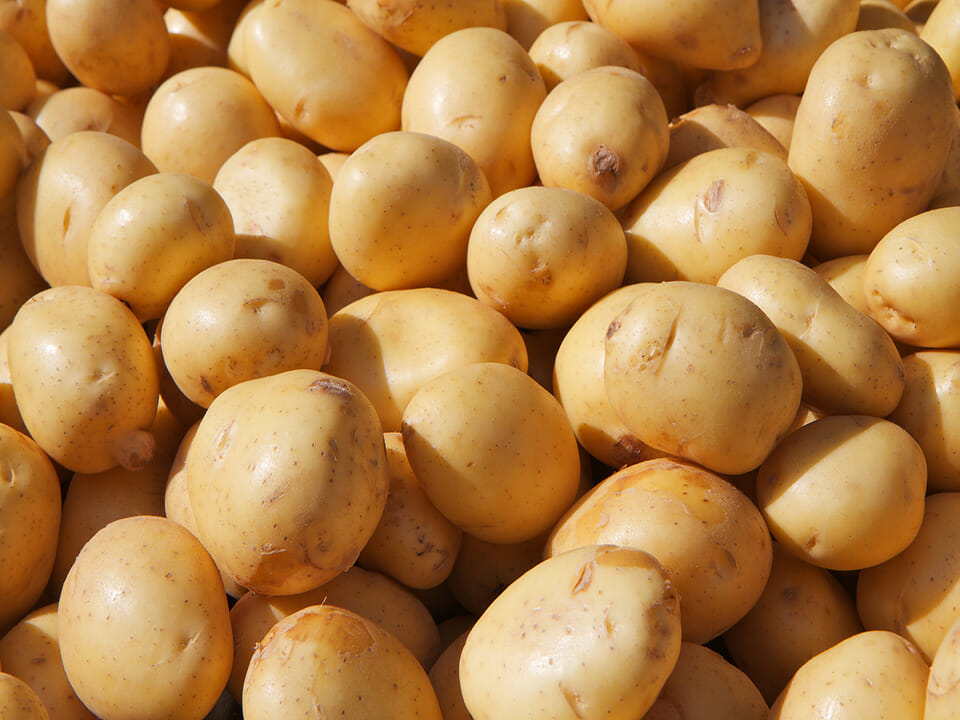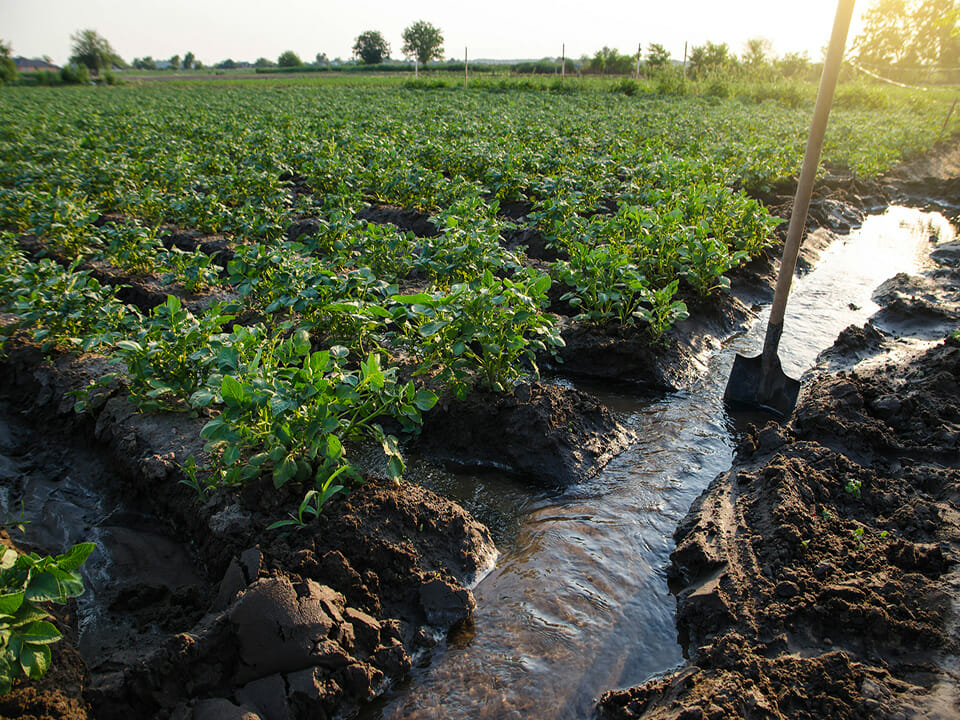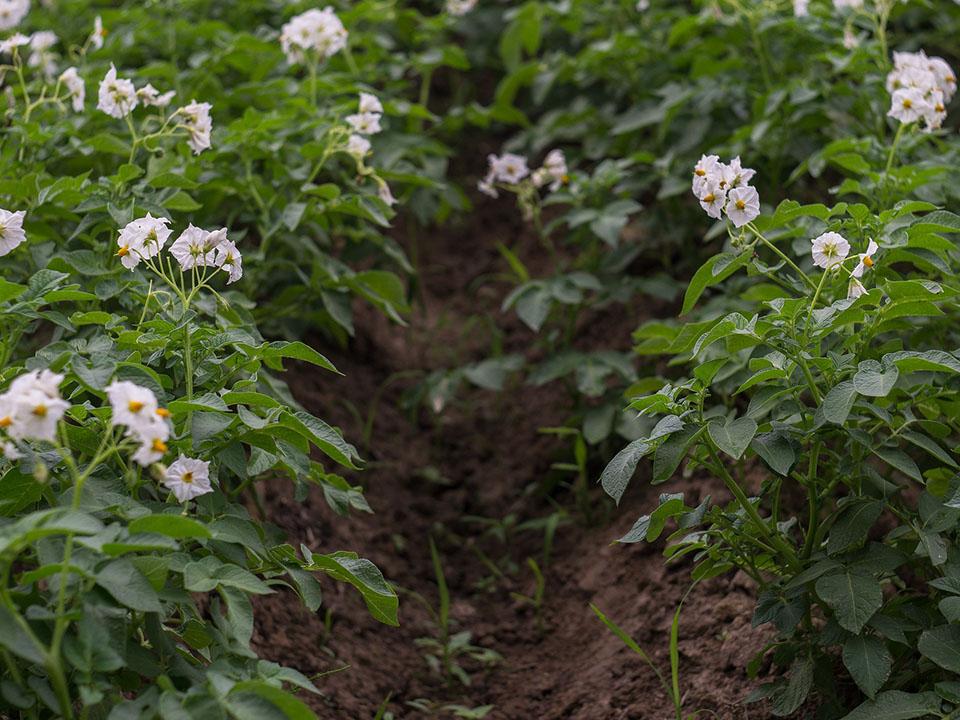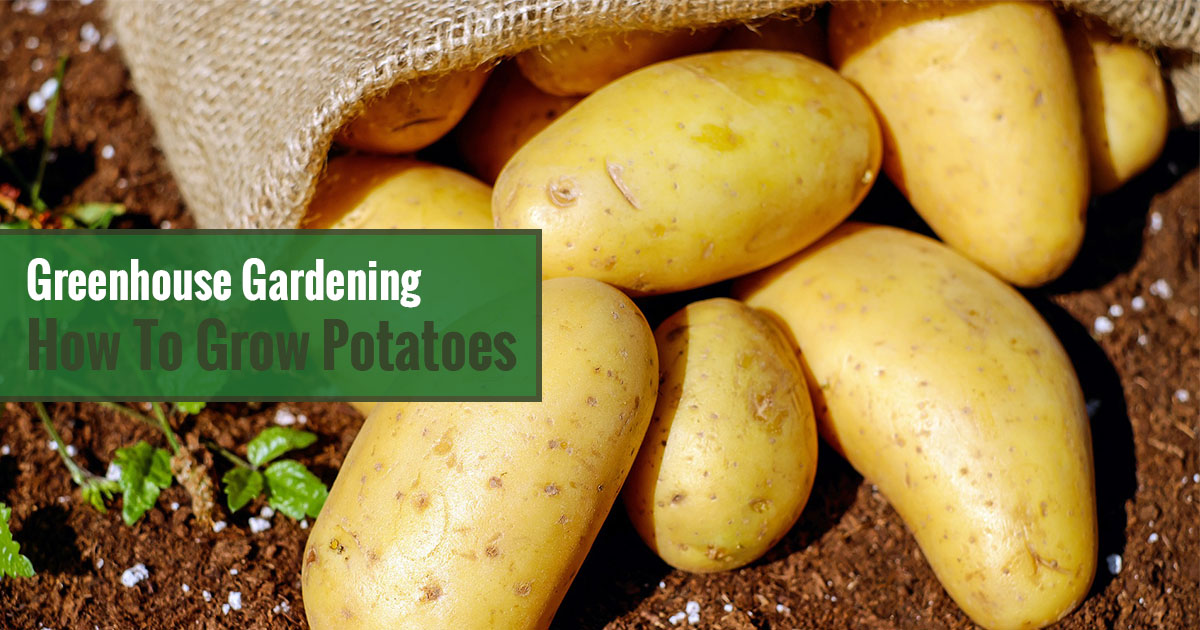You can easily grow potatoes in a greenhouse so you can harvest your favorite varieties all year round. Plus, growing potatoes in a greenhouse, hoop house, or cold frame not only keeps potato plants safe from frost but also numerous pests. You can grow potatoes in raised beds, grow bags, or pots, so you can even do it in small spaces.
To grow potatoes in a greenhouse, you’ll want to first find seed potatoes of your preferred variety, then decide on a location. You can grow potatoes in a raised bed, but any container that’s at least 24 inches tall and about 18 inches in diameter will do.
When done right, you can get continuous harvests of potatoes that taste better than anything you can find in the store. So are you ready to get your hands dirty and learn how to grow potatoes in a greenhouse? Read on!
Quick overview of growing potatoes in a greenhouse
- Type: cold-season crop
- Time from seed to harvest: 80-100 days
- Germination temp: 40°F
- Time until first emergence: 14-28 days
- Best temp to grow: 65-70°F
- Height: 18-36 in
- Spread: 18-36 in
- Grow from seed: 7-8 in deep, 10-12 in apart in rows 36 in apart;
- Companions: cabbage, corn, chives, cilantro, leeks
- Keep away from: tomatoes, eggplants, fennel, pumpkins, root vegetables
The benefits of growing potatoes in a greenhouse
Garden potatoes are typically planted a few weeks before the last frost date, or when the soil is at least 45-55°F. In most regions, this is usually around April. But in warmer climates, potatoes are often planted in the fall or even winter for a spring harvest!
Because they are frost-tender and don’t love extreme heat, potatoes grown outside are limited to the seasons. In a greenhouse, however, you can control variables such as light and temperature, allowing you to extend the growing season. This way you can easily have several harvests of potatoes in a single year, or more!
You can grow potatoes in the winter
There’s nothing quite like a freshly-harvested potato. Like tomatoes, they taste remarkably better fresh than they do after weeks or months of storage.
In winter, grocery stores typically only stock a handful of potato varieties that have been kept in storage since the previous season or have been imported from abroad. With a greenhouse, you can plant potatoes using a method called succession planting, planting potatoes in intervals so you can have regular, extended harvests!
Depending on your climate, you can grow potatoes this way in the winter even in an unheated greenhouse. Even in colder climates, you can continue growing your potatoes through the winter as long as you supplement with some heat and light.

How to pick the right variety of potato to grow
Did you know that there are thousands of varieties of potatoes? Historically, they’ve been cultivated throughout the Andes, particularly in Peru, but over the last two centuries they’ve become one of the top food crops in the world.
Grocery stores typically only carry a handful of the most popular potatoes, such as Russets or Burbanks. When growing potatoes at home or in your greenhouse, you can choose from many different kinds of potatoes, which is both an exciting and daunting opportunity.
To make it a little easier, we’ll help you understand the three main kinds of potatoes, and some of our favorite varieties to grow in the greenhouse!
First early potatoes
First early potatoes are also known as “new” potatoes because they’re typically the first ones to be harvested. These varieties are usually planted a few weeks before the average last frost date because they can tolerate a light frost.
For that reason, first early potatoes are a particularly good option for growing in a greenhouse during the winter, especially an unheated one.
Our favorite varieties of first early potatoes to grow in the greenhouse include: Yukon Gold, Dark Red Norland, and Purple Viking.

Second early potatoes
As suggested, second early potatoes, or mid-season potatoes, take a few more weeks to mature than first early potatoes. They taste best when just harvested, so they’re a great option to grow at home for year-round eating.
An often-overlooked advantage of growing first early or second early potatoes is that they tend to be less prone to common potato diseases, because the potatoes are harvested before the disease has had a chance to take hold.
Our favorite varieties of second early potatoes to grow in the greenhouse include: Kennebec, Red Chieftain, and Gold Rush.
Maincrop potatoes
Maincrop potatoes, or late-season potatoes, take the longest to mature and set good-sized potatoes. Due to the longer growing season, these varieties tend to be better for long-term storage and are more often found in grocery stores.
Maincrop potatoes are a good option for greenhouse growing if you have a short growing season but would still like to grow some good storage potatoes. These potatoes tend to be great options for baking, mashing, or frying.
Our favorite varieties of maincrop potatoes to grow in the greenhouse include: Burbank Russet, French Fingerling, and German Butterball.

How to plant potatoes in a greenhouse
Depending on your greenhouse setup, you have several different options for planting potatoes. You can either choose to grow potatoes in pots or raised beds, and both have some distinct advantages.
Planting in pots vs. raised beds
Planting potatoes in pots or planters makes growing potatoes easy. When placed in your greenhouse, your potatoes are safe from many animals, pests, and diseases, but also give you the flexibility of moving them around.
While any pot at least 24 inches deep and 12-18 inches wide will be able to accommodate 1-2 potato plants, you can also find many specialized potato planters. Compared to other pots, these planters have openings that allow for observing your potatoes as they develop and harvesting “new” potatoes without digging.
It’s important that the container you choose is deep enough to add more soil as the plants grow in a process called hilling. This protects your potatoes from the sunlight and results in a better harvest.
While growing potatoes in a container is easy, you can also plant your potatoes in raised beds with no issues. Just make sure that the bed is deep enough for the roots to develop properly, and that you have room to hill the potato plants several times through their growing season.
Planting preparation
When planting potatoes in a raised bed, you can plant them just as you would if you were farming an open field. Keep in mind that potatoes thrive in loose, well-drained soil, so the beds should have compost or high quality potting soil. Potatoes are also high feeders, so it’s a good idea to mix in some organic fertilizer at the time of planting.
If choosing to plant in containers, you might consider choosing a planter bag made of fabric or sturdy plastic. These flexible bags are great for growing potatoes because they allow the spuds to grow relatively freely.
Whichever method you choose, it’s good to chit your potatoes first. This process is simple: just set the seed potatoes out in a dark spot in your greenhouse to allow them to start developing some sprouts on the eyes!
Lastly, because potatoes are sensitive to freezing temperatures, it’s important to either heat your greenhouse or use frost covers if there are indications that the temperature may fall below freezing.
How to plant seed potatoes
Planting potatoes is incredibly easy. Just keep these tips in mind:
- Make sure to only use certified seed potatoes that are disease-resistant and haven’t been treated with sprout inhibitors.
- Examine the seed potatoes thoroughly before planting and cut off all symptoms of rot.
- Larger seed potatoes can be cut in multiple pieces that have at least 1-2 eyes. Seed potatoes smaller than an egg should be planted whole.
- Allow at least 24 hours for cut exteriors to harden before sowing, or the seed potato may rot in moist soil before it has a chance to sprout.
- Some gardeners allow the seed potatoes to grow sprouts before planting by leaving them in a dark and warm place 60-85°F. If you do this, be careful not to break the sprouts off when handling.
- When planting in a raised bed, plant seed potatoes about 12 inches apart (eye side up!) and space the rows about 3 feet apart. Cover the potatoes with approximately 3-4 inches of soil and water well.

How to care for potatoes in a greenhouse
To ensure a good crop of potatoes, you can’t just leave them alone and forget about them for 4 months. Luckily, it doesn’t take a lot of effort to care for potato plants.
Hilling up potato plants
Unlike most plants, potato plants will develop new roots (and tubers) when the stem gets covered up in a process called “hilling up.”
There are a few reasons why hilling up is important for potatoes. First, if potatoes are exposed to daylight, they will start to turn green. While the chlorophyll isn’t dangerous, it indicates the presence of solanine, a toxic compound that can cause headaches or nausea when consumed.
Another purpose of hilling potatoes is to improve the harvest, as more potatoes will develop along the submerged stem.
The best time to start hilling is when your plants attain a height of 8-12 inches:
- Add more soil or compost along both sides of the stem in a hill formation. When growing in containers, simply add more soil to the pot.
- Proceed to “earth up” every time the plants are at least 4 inches above the soil. If you are planting in a container, continue hilling until you are up to 2 inches from the top of your container.
Hilling up has the added benefit of preventing weed problems, cooling the soil, and preserving moisture. At the end of the season, you can reuse the soil in the garden or add it to your compost pile.
Water requirements
Your potatoes will rot in the soil if they are overwatered, but that doesn’t mean they should sit dry, either. Make sure to water your potato plants regularly, especially when tuber-formation begins. Remember that soil in containers dries out faster than in raised beds, so be prepared to water more often.
Maintain a moist (but not soggy) soil when the potato plants begin sprouting until a few more weeks after blossoming. Avoid watering too much in the first few weeks after planting to avoid the seed potatoes from rotting or developing disease.
It is best to use rainwater from a water barrel instead of tap water. Tap water usually has a neutral to high pH or alkaline and potatoes grow best in slightly acidic soil with a pH of 5.5. They can develop scab in more alkaline soils.

Soil requirements
Potatoes are heavy feeders, so make sure to plant them in rich soil with organic fertilizer mixed in. Potatoes grow best in an acidic soil between 5 and 5.5, in more alkaline soils potatoes tend to develop scab. You can test your soil pH easily at home, and amend if needed with sulfur or pine needle mulch.
Another tip to get near-perfect skins for your potatoes is to put the compost into a shredder to make a fine blend.
Common potato pests and diseases
One of the most common issues with home-grown potatoes is the development of scab, or rough patches on the skins that are tough and ugly. Potato scab is usually caused by high pH levels in the soil, which can be amended if necessary.
Every potato grower’s worst fear is potato blight, which usually emerges after a period of warm, wet weather. If your greenhouse is particularly warm and humid, you’ll have to keep an eye out for signs of blight. You can grow early potatoes to further reduce the risk, but make sure to always use fresh soil and rotate crops in raised beds.
Aphids are small pests that may feed on foliage and spread viral diseases. They extract fluids from the leaves and stems of your potato plants, which may cause serious damage. Insecticidal soaps are effective at controlling infestations, or you can manually remove the bugs with a jet of water.
Colorado potato beetles can be handpicked or be eaten by birds. If you see more of them, you can apply an organic pesticide at dawn or dusk to prevent hurting beneficial insects.
How to harvest your greenhouse-grown potatoes
Potatoes, especially those of the earlier varieties, take between 80-100 days to mature. Cut off the water supply about a week before the anticipated harvest date. This helps to ensure the soil in your greenhouse or planter is dry enough for harvesting.
After your potato plants start to flower, you can collect some early “new” potatoes. The plant heads will die back eventually, at which point the whole crop can be harvested. Dig gently with a garden fork to avoid puncturing the tubers.

For potatoes grown in containers, simply empty out the soil onto the ground or in a wheelbarrow and separate your potatoes by hand. Ensure you harvest all tubers no more than a few weeks after the vines die back so that the tubers don’t rot in the ground.
Harvest your potatoes on a dry day to simplify your job. A wet soil could mean that you will have to wait until the potatoes are air-dried before placing them into bags or boxes.
Storing your potatoes
Greenhouse-grown potatoes are best eaten the day they’re harvested, but they can be stored if needed. Store potatoes in a cool dry place preferably around 45-60°F for up to a couple of weeks. This will let their skins cure and help them last longer.
Brush off any remaining soil after curing. Don’t wash the potatoes unless you are ready to cook them. Washing them may reduce their shelf life. Place them in a dark and humid place with a temperature of around 38-40°F.
Also, don’t put your potatoes near apples to prevent them from spoiling. Apples contain ethylene gas which makes them ripen faster. Don’t refrigerate your potatoes.
























